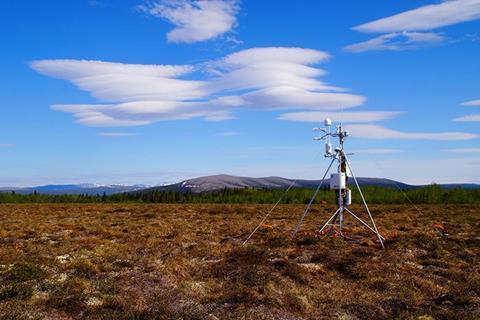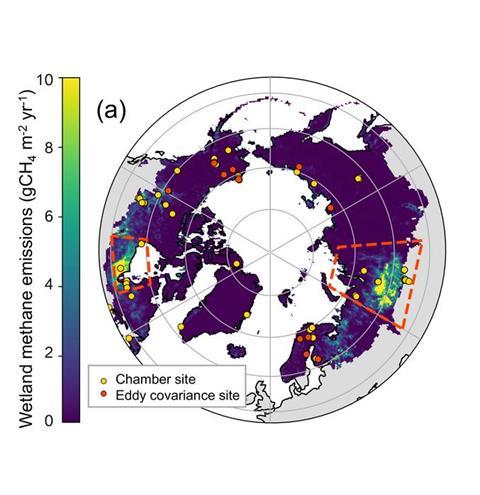Wetlands are Earth’s largest natural source of methane, a potent greenhouse gas that is about 30 times more powerful than carbon dioxide at warming the atmosphere.

A research team from the Department of Energy’s Lawrence Berkeley National Laboratory (Berkeley Lab) analyzed wetland methane emissions data across the entire Boreal-Arctic region and found that these emissions have increased approximately nine percent since 2002.
Livestock and fossil fuel production are well studied for their role in releasing tons of methane per year into the atmosphere. Although more uncertain, quantifying natural wetlands emissions is important to predicting climate change. Scientists expect that wetland methane emissions are rising because temperatures in Boreal and Arctic ecosystems are increasing at about four times the global average rate, but it’s hard to say by how much because monitoring emissions in these vast and often water-logged environments has been so difficult – until now.
Vulnerable to warming
“Boreal and Arctic environments are carbon rich and vulnerable to warming,” explains Qing Zhu, a Berkeley Lab research scientist and senior author, along with Berkeley Lab postdoctoral researcher Kunxiaojia Yuan, of a new study that analyzed data collected from several advanced monitoring methods to find the nine percent emissions increase over the past two decades. A paper published in Nature Climate Change this week describes their approach.
“Rising temperatures increase microbial activity and vegetation growth, which are associated with emissions of gasses like methane. By understanding how natural sources of methane are changing, we can more accurately monitor greenhouse gasses that inform scientists about the current and future state of climate change,” Zhu says.
Despite the fact that methane stays in the atmosphere for far less time than carbon dioxide – 10 versus 300 years – methane’s molecular structure makes it 30 times more capable of warming the atmosphere than CO2.
Water-logged soils
Higher temperatures not only enhance microbial activity of methane-releasing microbes found in saturated soils, but they also increase the area that has water-logged soils where these microorganisms thrive as frozen soils thaw and more precipitation falls in the form of rain instead of snow. This is why scientists have expected methane emissions to have increased in these higher-latitude regions, and why more accurately quantifying methane is urgent.
The most common way to measure the release of greenhouse gasses is to trap gasses emitted from soils at a fixed location within a chamber, allowing them to build up over a set period of time. Another method, the more autonomous several-meter-tall eddy covariance towers, continuously measure greenhouse gas exchange between soils, plants, and the atmosphere across large expanses of an ecosystem – and often in hard-to-reach places like wetlands.
The Berkeley Lab research team combined data acquired using both methods to analyze over 307 total years of methane emissions data across wetland sites in the Arctic-Boreal region, creating a better picture of factors influencing emissions across hundreds of acres of land and across minutes to decades.
55 Empire State buildings
The research team found that from 2002 to 2021, wetlands in these regions released an average of 20 teragrams of methane per year, or as much as the weight of about 55 Empire State buildings. They also found that emissions have increased approximately nine percent since 2002.
Additionally, the researchers considered two “hotspot” areas in the Arctic and Boreal regions, which have significantly higher methane emissions per area compared to surrounding environments. They found that about half of the average annual emissions were coming from these hotspots, which helps to inform and target mitigation efforts and future measurements.

The researchers also investigated which environmental factors explained the higher methane emissions, finding two major drivers: temperature and plant productivity.
Higher temperatures increase microbial activity; when temperatures rise – whether it be on average because of climate change, or in some particular years due to climate variability, more methane is released in the process. The team found that temperature was the dominant control on wetland emissions and their variability in the Boreal-Arctic ecosystems. This can lead to climate feedbacks where methane emissions from increased microbial activity increase atmospheric temperatures, leading back to more methane emissions, and so on.
Plant productivity
Higher plant productivity increases the amount of carbon in the soil, which fuels methane-producing microbes. The researchers found that when plants were more productive and active, releasing substrates that help microbes to thrive, wetland methane emissions increased.
The team also identified that the year with the highest wetland methane emissions, 2016, was also the warmest year in the high-latitudes since 1950.
Because methane has a fairly short lifetime in the atmosphere, it can be reduced and removed relatively quickly,” Zhu explains. “By providing a more accurate understanding of the role wetlands play in the global climate system and how and at what pace their methane emissions have increased, this research can offer a scientific baseline to help understand and address climate change.”
This research is supported by the Department of Energy Office of Science and NASA.







No comments yet